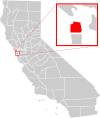Embarcadero (San Francisco)

The Embarcadero is the eastern waterfront and roadway of the Port of San Francisco, San Francisco, California, along San Francisco Bay. It sits atop an engineered seawall on reclaimed land. The name derives from the Spanish word embarcar, identifying it as the place to embark.
It begins at the intersection of 2nd and King Streets near AT&T Park, and travels north, passing under the San Francisco – Oakland Bay Bridge. The sidewalk along the waterfront between Harrison Street and Broadway was named "Herb Caen Way..." after the death of celebrated local columnist Herb Caen in 1997. The three dots, or ellipsis, deliberately are included in honor of columnist Herb Caen's Pulitzer Prize winning writing style. The Embarcadero continues north past the Ferry Building at Market Street, Fisherman's Wharf, and Pier 39, before ending at Pier 45. A section of The Embarcadero which ran between Folsom Street and Drumm Street was formerly known as East Street.
History
San Francisco's shoreline historically ran south and inland from Clarke's Point below Telegraph Hill to present-day Montgomery Street and eastward toward Rincon Point, enclosing a cove named Yerba Buena Cove. As the city grew, the cove was filled. Over fifty years a large offshore seawall was built and the mudflats filled, creating what today is San Francisco's Financial District. The San Francisco Belt Railroad, a short line railroad for freight, ran along The Embarcadero. The roadway follows the seawall, a boundary first established in the 1860s and not completed until the 1920s.
During the early-20th century when the seaport was at its busiest and before the construction of the Bay Bridge, the trolley loop, now the trolley plaza, in front of the Ferry Building was one of the busiest areas of foot traffic in the world; only Charing Cross Station in London and Grand Central Terminal in New York City were busier.[citation needed] Piers 1, 1½, 3 and 5 (which now comprise the Central Embarcadero Piers Historic District) were dedicated chiefly to inland trade and transport. These connections facilitated the growth of communities in the Sacramento and San Joaquin Valleys and fostered California's agricultural business. The Delta Queen docked at Pier 1½, ferrying people between San Francisco and Sacramento. There was once a pedestrian footbridge that connected Market Street directly with the Ferry building and a subterranean roadway to move cars below the plaza. In the earliest days, a maze of cable car tracks terminated here, servicing the ferry commuters. These were eventually replaced by a loop for several streetcar lines.
During World War II, San Francisco's waterfront became a military logistics center; troops, equipment and supplies left the Port in support of the Pacific theater. Almost every pier and wharf was involved in military activities, with troop ships and naval vessels tied up all along the Embarcadero.
However, after the completion of the Bay Bridge and the rapid decline of Ferries and the Ferry Building, the neighborhood fell into decline. The transition to container shipping, which moved most shipping to Oakland, led to further decline. Automobile transit efforts led to the Embarcadero Freeway being built in the 1960s. This improved automobile access to the Bay Bridge, but detracted aesthetically from the city. For 30 years, the highway divided the waterfront and the Ferry Building from downtown. It was torn down in 1991, after being severely damaged in the 1989 Loma Prieta earthquake.

After the freeway had been cleared, massive redevelopment began as a grand palm-lined boulevard was created, squares and plazas were created and/or restored, and Muni's N Judah and T Third Street and F Market & Wharves lines were extended to run along it, with the N and T lines going south from Market Street to 4th and King Streets (at AT&T Park and the Caltrain station) and the F line going north from Market to Fisherman's Wharf. The Market Street Railway is also planning a new ‘E’ line to run up the Embarcadero, past the wharves, to Aquatic Park.
A sculpture, "Cupid's Span" by Claes Oldenburg and Coosje van Bruggen, was built in 2003 along the Rincon Park area. Resembling Cupid's bow and arrow with the arrow implanted in the ground, the statue symbolizes the place where Tony Bennett "left his heart".
Subway station
Embarcadero Station, a BART and Muni Metro subway station, is located at the foot of Market Street, one block from The Embarcadero. While not in the original system plans, the area had become quite busy at the time of the BART construction. The late addition is the reason for the station's distinctive design.
Embarcadero Center
Embarcadero Center consists of four large (30-45 story) buildings and the Vaillancourt Fountain, at Justin Herman Plaza and Four Embarcadero Center, between the Ferry Building and the foot of Market Street. Until 2001, there was a viewing deck on top of the Embarcadero Center. During the winter holidays, the edges of all four buildings are illuminated , the effect resembling the outlines of four giant books on a shelf.
External links
- 7x7 magazine's video of 49-Mile Drive, part 1 (San Francisco's Twin Peaks, Dolores Park, and The Embarcadero)


